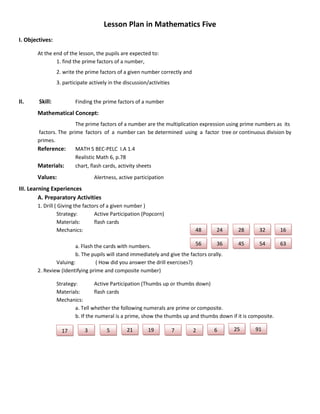
Lesson plan in elementary mathematics five
- 1. Lesson Plan in Mathematics Five I. Objectives: At the end of the lesson, the pupils are expected to: 1. find the prime factors of a number, 2. write the prime factors of a given number correctly and 3. participate actively in the discussion/activities II. Skill: Finding the prime factors of a number Mathematical Concept: The prime factors of a number are the multiplication expression using prime numbers as its factors. The prime factors of a number can be determined using a factor tree or continuous division by primes. Reference: MATH 5 BEC-PELC I.A 1.4 Realistic Math 6, p.78 Materials: chart, flash cards, activity sheets Values: Alertness, active participation III. Learning Experiences A. Preparatory Activities 1. Drill ( Giving the factors of a given number ) Strategy: Active Participation (Popcorn) Materials: flash cards Mechanics: 48 24 28 32 16 a. Flash the cards with numbers. 56 36 45 54 63 b. The pupils will stand immediately and give the factors orally. Valuing: ( How did you answer the drill exercises?) 2. Review (Identifying prime and composite number) Strategy: Active Participation (Thumbs up or thumbs down) Materials: flash cards Mechanics: a. Tell whether the following numerals are prime or composite. b. If the numeral is a prime, show the thumbs up and thumbs down if it is composite. 17 3 5 21 19 7 2 6 25 91
- 2. 3. Motivation Give number combinations that will give the product of 18. Expected Answer X 2 X 9 = 18 X 3 X 6 = 18 X 1 X 18 = 18 B. Developmental Activities 1. Presentation Strategy 1: Making an Organized List Group Activity a. Use the prime numbers listed on the board ( 2, 3, 5, 7 ) as factors. b. Find a combination of prime numbers, multiply them and record the number sentence. c. Write all the findings in a table or chart. Expected outputs Number Sentence Product 2x3 6 2x5 10 2x7 14 3x5 15 3x7 21 5x7 35 2x3x5 30 2x3x7 42 3x5x7 105 2x3x5x7 210 Analysis and Discussion: a. Ask, “What can you say about the factors of these products? ( They are all prime numbers. ) b. Elicit from the pupils that those are the prime factors of the numbers. c. Reverse the situation. Give the product and the pupils give the prime factors. d. Ask, “Given number is 36, What are its factors? e. How can we write 36 as a product of its prime factors? f. Let the pupils list the factors of 36. g. Let them list the prime factors of 36. 36 = 6 x 6 2x3x2x3 36 = 2 x 2 x 3 x 3
- 3. Strategy 2: Factor Tree a. Give each group two-digit numbers and a factor tree printed on a cartolina. b. Have the pupils determine two factors of the given number. Write them on the first two boxes of the factor tree. c. Find the two factors of the first two factors. Write them on the next two boxes. d. Continue extracting factors of the number until the last box contains prime numbers. 48 45 8 6 9 5 4 2 2 3 3 3 Prime factors of 45 = 3 x 3 x 5 2 2 So, the prime factors of 48 = 2 x 2 x 2 x 2 x 3 Strategy3: Continuous Division by primes 2 36 2 54 Prime Factors of 36 Prime factors of 54 2 18 36 = 2 x 2 x 2 x 3 3 27 54 = 2 x 3 x 3 x 3 2 9 3 9 3 3 3 3 1 1 2. Fixing Skills Find the prime factors of these numbers using the two methods. Slow learners: Average learners: Fast learners: a. 16 a. 36 a. 64 b. 24 b. 48 b. 72 c. 12 c. 50 c. 120 d. 18 d. 54 d. 210
- 4. 3. Generalization How do you find the prime factors of a number? We can find the prime factors of a number through: a. factor tree method b. Continuous Division by Primes C. Application 1. How would you begin to find the prime factors of 246? 2. Give the prime factor of 1,000. IV. Evaluation Give the prime factors of the following number using any method. 1. 78 2. 72 3. 80 4. 150 V. Assignment Write the prime factors of the following numbers. 1. 84 5. 93 2. 240 6. 110 3. 60 7. 91 4. 42 8. 50
